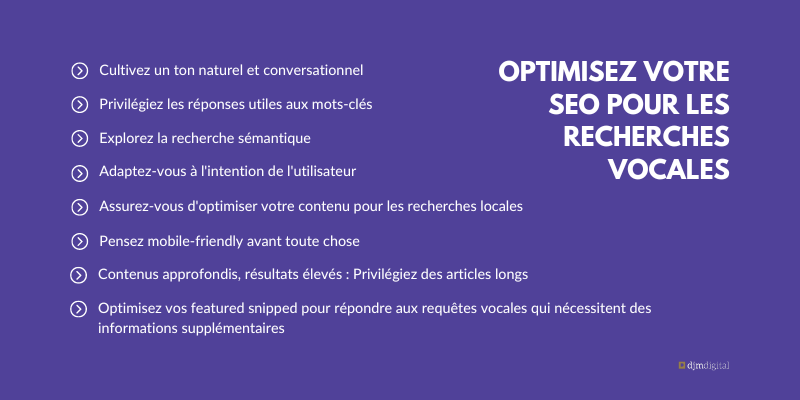What if the purchasing process became instantaneous thanks to the power of the voice? The growing integration of voice search into our daily lives is undeniable. But how can we adjust our content to appeal to those who navigate by hearing rather than by sight?
Voice Commerce, or V-commerce, encompasses the search for products, the creation of shopping baskets and the completion of purchases via connected speakers or voice commands on smartphones. Its primary objective is to simplify the purchasing process by offering a powerful alternative to traditional methods.
In 2018, a PwC survey revealed that 71% of consumers already prefer voice searches to written queries via their smartphone. In 2023, it is becoming undeniable for marketers to take an interest in the growth of voice search as an additional acquisition lever in order to reach their audience in innovative and more effective ways.
Online shopping could become even more diversified, freeing itself from any visual dependency and relying solely on the vocal skills of artificial intelligence. So why not seize this opportunity to grow your business?
The importance of voice search in marketing
According to a survey carried out by Abode on a panel of consumers, 1/3 of participants said that voice advertising messages seemed less intrusive to them than online or television advertising. What’s more, according to a worldwide study conducted by Microsoft, 1/4 of these users are already using the voice search function on their mobile phone. Why is this data so decisive?
Technological developments and new devices incorporating voice recognition have expanded rapidly over the last decade. Voice search is revolutionising the way users interact with technology and approach the search for information.
Consumers are increasingly adopting voice search because of its convenience. Prospects’ queries are becoming more elaborate, even conversational. This new method of consumption has a direct impact on marketers and their keyword, content and lead generation strategies.
Voice search is opening up new marketing opportunities. Voice interfaces are seen as new communication channels for companies to showcase their products and services in a different way. Ultimately, this (new) channel has a considerable impact on company websites, as content also needs to be reworked for users’ spoken queries.
What are the benefits of voice marketing for your company?
Voice marketing offers new opportunities to captivate customers and boost conversions. So how can you make the most of this marketing practice? And what are the benefits of using voice compared with traditional, visual interfaces?
Speed of execution
Voice assistants can considerably improve the customer experience and the time it takes for a prospect to close. Thanks to its speed of execution, voice search is a practical and rapid means of activation. Consumers are searching faster and want to be effectively guided through the process by an assistant powered by artificial intelligence. Marketers therefore need to think about the user experience both for the prospect and for the artificial intelligence, which needs to fill in your information in the most relevant way possible for your potential leads.
More detailed information about your online audience
Voice also offers a more natural experience than typing on a keyboard. It allows a more detailed expression of the prospect’s wishes, needs and, of course, emotions. By formulating their needs by voice, users communicate (and search) in a more intuitive and natural way, triggering the use of new long-tail keywords. This type of data also influences visual marketing, whether online or offline. The more a company learns about its customers’ communication style, the more impactful its campaigns can be for prospects.
Voice assistants also play an important role in your brand’s communication. They must meet the expectations of their human interlocutor. With the evolution of this technology, voice assistants now respond with vocal inflections and humorous touches to a growing range of questions. Companies can leverage this channel to personalise virtual assistants specific to their brand, creating brand ambassadors and moving beyond the digital world.
The use of virtual assistants also allows companies to gather valuable data on buying habits, how they communicate them and customer preferences, enabling them to improve their marketing strategies and provide an increasingly personalised service.
Significant freedom of action
In many situations where ‘hands-free’ is essential, the use of voice is preferred. It is therefore possible for brands to reach their prospects at various opportune moments, when the latter do not have access to their screens. The potential for conversion and the number of touch points with your target are therefore higher.
Voice search also makes it possible to help people with disabilities, reducing the digital barrier and ensuring that more people have access to information.
Greater availability for consumers
As mentioned above, companies can afford to be more available and at the service of their customers thanks to voice search or dedicated voice assistants. This opens up an opportunity for customer service. In this case, and following the example of a chatbot powered by artificial intelligence, the speed of processing customer requests and the response time are greatly optimised, helping to reduce frustration levels.
How can you integrate voice search into your marketing and v-commerce strategy?
Use of conversational keywords
The increasing use of voice assistants is forcing companies to rethink their digital marketing strategies. Voice search is changing the way users interact with search engines, which has a direct impact on search engine optimisation (SEO).
To adapt, companies need to focus on long tail keywords, frequently asked questions and conversational content. What’s changing from traditional SEO (and also impacting on SEA) is mainly the fact that users now tend to ask complete questions rather than short phrases or keywords when they perform a voice search. This means that traditional SEO strategies may no longer be effective in reaching your audience in the best possible way.
Voice search also influences the way search results are presented. Voice assistants such as Alexa, Siri or Google Home often only read the first search result. This means increased competition for the top spot on the search console.
With traditional SEO, achieving a position on the first page of results is often satisfactory. However, in most cases, the user will browse several sites to find a relevant answer. Voice marketing, on the other hand, requires an obsession with first place or “position zero”. Voice traffic therefore implies that a brand must be the leader on the search tool. So don’t neglect your website’s SEO strategy.
Voice search engine: working on your SEO to respond to voice queries

Using voice UX to boost conversion
With the adoption of voice, the act of buying becomes both faster and more accessible at all times. This dynamic considerably optimises the user experience. What is now known as voice UX amplifies customer engagement, reduces customer transaction costs, improves task execution and optimises the efficiency with which the voice assistant handles our requests.
The constant evolution of voice technologies is resulting in increasingly precise assistants for consumers, guided by artificial intelligence. Personalised voice assistants will be able to identify the tone of voice of the person they are talking to, their accent and the way they express themselves.
This personalisation will make it possible to offer perfectly adapted products, influenced by purchase history, habits and the ratings given to past orders. It then becomes possible to cross-sell as well as up-sell via voice assistants and solely via a conversation with the prospect.
As in traditional marketing, it is vital to ensure a fluid experience when using voice devices, and that requests are understood quickly. At present, data on the user’s voice experience and ways of improving it are still limited.
The challenge of voice commerce for the retail sector
One of the main advantages of voice commerce is the simplicity and speed it offers consumers in the purchasing process. Rather than browsing websites, prospects can more easily and quickly express their requests out loud, which greatly reduces the frustration associated with the purchasing process.
A second advantage of v-commerce is customer loyalty. It is important for brands to focus on repeat orders through this marketing practice. Once customer data is established in the system, voice commerce enables very rapid repeat orders, particularly for consumable products. Offering discounts for repeat voice commerce orders could further encourage this practice.
A personalised buying experience
Finally, a significant benefit of this purchasing process is undoubtedly the personal and personalised nature of the customer journey. According to a Shopify survey, 80% of customers surveyed prefer a personalised shopping experience such as that offered by voice commerce, with its recommendations. The personalisation of the voice assistant also plays an important role from a psychological point of view.
A major challenge for retailers
The retail sector is therefore one of the first to be able to take advantage of this marketing practice to boost sales. However, a survey conducted by Steerfox shows that 83% of voice search users are reluctant to take the plunge into voice purchasing. The fundamental challenge for the retail industry is to resolve the voice commerce barrier, which has not yet been fully integrated by many households.
The dematerialisation of the purchasing process, the lack of confidence in this practice, which is still not widely used in retail, and the frequent changes in the AI sector, can give rise to concerns among consumers and brands alike. This is a potential obstacle to the widespread adoption of voice commerce. It is therefore up to companies to highlight this practice by emphasising its advantages in terms of security and trust, and to enlist the support of specialists who can develop this technology for them. The development of voice UX would also help to overcome these psychological obstacles for consumers.
Internally, the biggest challenge for brands lies in their ability to emerge at the top of search results, in order to position themselves strategically. This is where voice commerce faces a potential dilemma: prioritising the products of major market players, at the risk of relegating alternatives and new brands to the background. Then there is the need to adopt this technology to traditional sales processes.
Artificial intelligence for v-commerce
Some companies have now decided to build their core business on this voice market. Take VoiceLab, for example, which offers alternative voice content. VoiceLab.AI, for example, specialises in conversational AI and offers a wide language model (LLM) that follows instructions and has been refined for a number of business areas such as e-commerce and customer support. Their promise? To put voice data analysis at the heart of their business in order to help their partners increase their sales conversion rate, thereby generating revenue while reducing the costs of your customer service.
Conclusion
Voice search offers new marketing opportunities. Brands can create more engaging voice interactions with consumers and promote their products in a more immersive way. However, this requires a deep understanding of the context of use and a more subtle approach to avoid being intrusive.
One of the main advantages of voice search is the simplicity and speed it offers consumers. Rather than browsing websites, they can simply express their queries aloud, making the buying process much easier. This convenience is particularly useful in situations where consumers have their hands full, such as when cooking, driving or playing sport. Retailers are therefore strongly advised to adapt their SEO and content strategies to cater for these specific searches too, while integrating seamlessly with their other distribution channels.
Despite its potential, voice commerce must overcome a number of technical challenges, such as accurately understanding different accents and dialects. In addition, consumers need to be reassured about the security and confidentiality of their data when making purchases by voice.
In short, voice search and v-commerce are transforming the way consumers interact with brands and make purchases. This is a trend that cannot be ignored by retailers wishing to remain competitive and offer innovative and practical customer experiences.

Social media expert, Marie is part of our e-marketing team. Creative and always looking for the latest trends, she shares with you her knowledge and mastery of Facebook, Instagram, Tik Tok, Pinterest and other social media algorithms!



